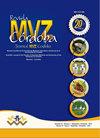Diferencias de especie en las concentraciones plasmáticas y tisulares de florfenicol entre ovinos y conejos
IF 0.3
4区 农林科学
Q4 AGRICULTURE, DAIRY & ANIMAL SCIENCE
引用次数: 0
Abstract
Objective. The aim of this study was to compare tissue and plasma concentrations of florfenicol (FFC) and its metabolite florfenicol amine (FFC-a) between sheep and rabbits, after intramuscular administration of 20 mg FFC/kg. Materials and methods. Five Suffolk Down sheep and six New Zealand rabbits were used in this study. Blood samples were collected before FFC administration and at 0.25, 0.5, 1, 1.5, 2, 3 and 4 hours after treatment. At 4 hours after treatment, euthanasia was applied to animals. Plasma and tissue concentrations of FFC and FFC-a were determined by HPLC. Results. For FFC, maximum plasma concentrations, absorption rate, absorption half-life, distribution rate, and area under the plasma concentration-time curve were all found to be significantly higher in rabbits than in sheep. Similarly, for FFC-a, significantly higher maximum plasma concentrations and area under the concentration-time curve were observed in rabbits as compared to sheep. The metabolite ratio was higher in rabbits (12.7±3.07%) compared to sheep (3.99±0.87%) (p<0.05), as were the tissue concentrations of FFC and FFC-a. Conclusions. Significant differences in the pharmacokinetics and tissue concentrations of FFC, and its metabolite FFC-a, were observed between these two animal species. The higher concentrations of FFC-a in rabbits indicate a greater level of FFC metabolism as compared to sheep. This should be considered when establishing dosage and frequency of FFC administration for rabbits.绵羊和兔子血浆和组织中氟苯尼考浓度的物种差异
目标。本研究的目的是比较肌肉注射氟苯尼考(FFC) 20 mg /kg后,绵羊和家兔组织和血浆中氟苯尼考(FFC)及其代谢物氟苯尼考胺(FFC-a)的浓度。材料和方法。研究对象为5只萨福克绒羊和6只新西兰兔。分别于给药前和给药后0.25、0.5、1、1.5、2、3、4小时采集血样。治疗后4小时,对动物实施安乐死。HPLC法测定血浆和组织中FFC和FFC-a的浓度。结果。FFC在家兔体内的最大血浆浓度、吸收率、吸收半衰期、分布率和血浆浓度-时间曲线下面积均显著高于绵羊。同样,FFC-a在家兔中的最大血浆浓度和浓度-时间曲线下面积明显高于绵羊。家兔代谢产物比(12.7±3.07%)高于绵羊(3.99±0.87%)(p<0.05), FFC和FFC-a的组织浓度也高于绵羊(3.99±0.87%)。结论。在这两种动物之间,FFC及其代谢物FFC-a的药代动力学和组织浓度存在显著差异。家兔体内较高的FFC-a浓度表明其FFC代谢水平高于绵羊。在确定家兔FFC给药剂量和频率时应考虑到这一点。
本文章由计算机程序翻译,如有差异,请以英文原文为准。
求助全文
约1分钟内获得全文
求助全文
来源期刊

Revista Mvz Cordoba
农林科学-奶制品与动物科学
CiteScore
0.70
自引率
0.00%
发文量
41
审稿时长
6-12 weeks
期刊介绍:
The Journal MVZ Córdoba is an open access international scientific journal financed and edited by the University of Córdoba (Colombia). The journal publishes quarterly, continuously in PDF, XML, Epub, original articles, literature reviews, brief communications and clinical cases, peer-reviewed (double-blind) in Spanish and English, which are related to the agricultural and veterinary sciences. The journal is directed to natural and legal persons of veterinary medicine, animal husbandry, public health, epidemiology, aquaculture, biology, basic biomedical sciences and biotechnology and constitutes a space for academic and scientific discussion around the work of professionals in Veterinary Medicine and Zootechnics. Four-monthly publication.
"The Journal MVZ Córdoba supports the policies for registration of clinical trials of the World Health Organization (WHO) and the International Committee of Medical Journal Editors (ICMJE), since it recognizes the importance of these initiatives for international registration and dissemination. of information about clinical studies, in open access. As a result, since 2007, the journal MVZ Córdoba only publishes clinical research articles that have received an identification number in one of the Clinical Trial Registries validated by the criteria established by WHO and ICMJE, whose addresses are available in the ICMJE website. The identification number is recorded at the end of the summary. "
 求助内容:
求助内容: 应助结果提醒方式:
应助结果提醒方式:


